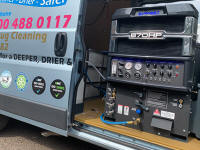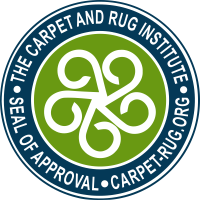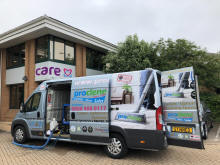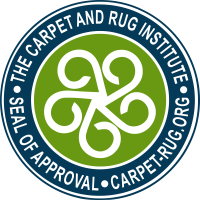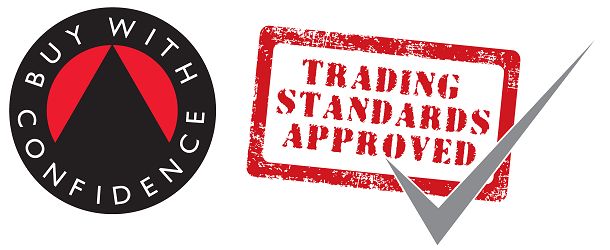Understanding CFM and Hg Technical Terms
CFM is a measurement of the speed at which air flows, known as Cubic Feet per Minute. Now imagine your wet clothes on the washing line; with little or no wind, they take a while to dry, but on a windy day, they dry so much faster. That is the importance of CFM when trying to reduce drying times.
With regards to Hg it is how much water lift a vacuum has. The higher the Hg, the greater the lift, with Hg defined in inches and 29,92" is known as a perfect vacuum. A perfect vacuum is unsuitable for cleaning because it would always create a complete seal, fluid wouldn't flow, and the liquid becomes trapped where it was, i.e. along a hose; therefore, there needs to be a break in the seal to allow air to flow and make the liquid move. A vacuum needs air movement for it to work as a cleaning aid.
To help you understand the science, use a wet-vac to start sucking water from a bucket, then immediately block the end of the hose with your hand, and wait 10 seconds before turning the vacuum off. When the vacuum motor stops, release your hand, and watch all the fluid run from the hose back into the bucket.
More CFM means more air movement through the fibres forcing the water and soil particles across the path of the vacuum, and with the increase in water lift, a greater mass of water gets removed at once, and the airflow also speeds up the drying. So basically, these two technical functions complement each other to provide deeper cleaning and faster drying.
Therefore 870 CFM and 14Hg is a finely tuned balance that extracts much more water and particles and creates a near-perfect wind to dry your wet cleaned carpets and upholstery in no time. Still, it will depend upon other factors such as humidity levels, room temperature and air circulation.
Compare this to what our competitors use;
Company 1 - uses a machine such as a Phoenix 450 van-mounted carpet cleaning machine. Even though it states 450, it is only 305 CFM and 11Hg.
Company 1 will offer you a low price, and will most likely not arrive if a more extensive job becomes available to them, either that or their machine or van breaks down. Because of the low prices they charge they cannot afford to maintain or repair their machines or vans and only do so when it's already too late. With little or no maintenance, plus the age of their machines, the performance will have degraded significantly, resulting in your carpets and upholstery taking so long to dry that they will start to smell terrible due to the bacteria and the mould that is already growing. Please don't get me wrong, not all companies neglect their equipment, but very few of them invest in newer technology or better machines. They also fail to invest in their skills and usually only care about making money before customer satisfaction and customer service.
Company 2 - uses a portable machine with 3 x 1.6kw vacuums (4.8kw) with a maximum of 149.4 CFM and only 5Hg. They will also need a 3Kw water heater.
When company 2 is cleaning a 3-bedroomed house based on today's cost of electricity, the additional cost to you will be
£18 plus
the water usage if you are on a meter. They will take 60% longer
due to waiting for water to reach temperature, filling with clean water, disposing
of dirty water, and bringing in the additional machines into your home. Plus, the extra extraction processes to achieve a decent clean will still
take a minimum of 24 hours for your carpets to dry.
It's a lot more inconvenience for a much less rewarding experience.
Carpet and Upholstery Fibres
Natural and man-made fibres each have their own characteristics and pros and cons, but within the carpet and upholstery manufacturing industry these are the main fibres that we see and regularly clean.
Natural Fibres
Wool
- One of the best fibres for carpet
- A protein fibre
- Naturally flame resistant
- Holds 30% of its own weight in moisture and still feels dry.
- Scales allow soils to be hidden, therefore, can look clean even when dirty.
- Alkaline cleaning agents will rot the fibres and affect the dyes
- Chlorine bleach dissolves wool
Enzymes will cause degeneration and must be neutralised and thoroughly rinsed out. - Wool attacked and eaten by moths
- White wool turns yellow with prolonged sunlight
Cotton
- Swells when wet
- Predominantly an upholstery fabric fibre
- Used as a foundation for rugs
- Cellulosic fibre, high risk of cellulosic browning when cleaning incorrectly
- Susceptible to mildew
- stains and soils very easily
- Takes more work to clean
- Acidic solutions can rot the fibres
- Resistant to Alkaline solutions but should not be used due to high risk of cellulosic browning.
- Absorbs approx. 27% of its own weight in moisture before feeling damp
Silk
- The only natural fibre produced as a continuous filament.
- Very strong luxury fibre
- used in rugs and upholstery fabrics
- protein enzymes will degrade it.
- damaged by acids, alkaline and bleach
- sunlight will rot the fibres
- perspiration will rot the fibres
- Absorbs 30% of its own weight in moisture before feeling damp
Linen
- predominantly cellulose with around 25% consisting of waxes and pectin giving it its lustre
- Stronger than cotton
- Moisture retention approx. 12% before feeling damp, therefore dries fairly quickly
- Does not soil easily, stains remain on the surface
- very easily damaged with bleach
- Damaged by acids
- Not easily damaged Alkalis
- Less stable dyes
- Expensive
Jute
- Derived from the inner bark of plants
- Used as a weft backing fibre in carpets
- lignin and acetyl is released when in contact with alkaline solutions causing cellulosic browning
- Absorbs moisture
- Swells when when causing carpets to shrink
- not stretchable
- sensitive to chemicals
- susceptible to mould and rot with prolonged dampness
Seagrass
Coir
Sisal
Man Made Fibres
Nylon
- As a continuous fibre it retains only 4.5% moisture
- staple fibre fabrics (namely carpets) are more absorbent because of the large amount of air between the fibres therefore a nylon carpet or carpet tile will remain wet for longer because air needs to access those air spaces to help with evaporation.
- smooth fibres make it resistant to soiling but susceptible to electrostatic charge through friction which attracts soil particles
- resistant to alkaline cleaners but may be damaged by mineral acids
- weekend with prolonged exposure to direct sunlight
- highly flammable
Polyester
- Lustrous in appearance but not as much as nylon
- extremely strong and resistant to abrasion
- not very absorbent
- fairly resistant to soiling
- water based stains not easily absorbed
- Oil and grease based stains easily absorbed and tricky to remove
- attracts soils through electrostatic
- Resistant to alkalis and bleaches but must be rinsed and neutralised.
- Highly flammable.
Acrylic
- Mainly used as a staple fibre
- Weaker than nylon and polyester
- Stronger than wool
- Does not soil easily and dirt cleaned easily
- less static soiling than nylon and polyester
- extremely flammable, will produce hydrogen cyanide when burned
Viscose Rayon
- Cheap to produce, expensive to purchase.
- regenerated cellulose fibre
- Not very strong and weakens by approx. 70% when wet
- 16% moisture retention and slow drying
- As a pile fibre we do not recommend wet cleaning
- As a woven fibre we can wet clean
Polypropylene
- holds less than 0.01% of its own weight in moisture, yet the water will still coat the fibres with a thin layer of water which still needs to evaporate, see air movement and humidity levels below.
Acrylic
Pile and Weave Types
Twist pile
Loop/Berber
Needle punch
Woven;
Carpet and Rug Construction Method
Tufted
Woven
Knotted
Velvet
Axminster
Wilton
Needle Punch
Other Factors
Other factors that we need to be taken in to account when cleaning and advising customers of drying times, include
Humidity; comes in to play more so during autumn and winter months, when the weather is wet and damp, having windows open will add to the moisture levels within the room, making the fibres dry slower.
Airflow; airflow speeds up the drying process because it takes minute amounts of moisture with it as it passes over the fibres, therefore speeding up the drying process. having a window or door open therefore reduces the drying time, however this is not possible during the autumn and winter months, luckily we have 870 CFM of airflow to significantly reduce the drying times, but it will still dry slower in the winter and autumn months.
Water Temperature; hot water evaporates much quicker than cold water because it is less dense, but we only use a water at a temperature that is safe for the fibre and fabric type, construction type and method of the item we are cleaning.
Water quantity; the more water we use the more we need to remove during the cleaning process, the more absorbent the fibre the more amount of water it can hold without feeling soaking wet, and the tighter the weave the more flushing of the fibres with water is required, the tightness of the fibres also make it more difficult to remove the moisture from within the weave therefore evaporation is slower and drying is longer
All reviews below can be proven that they are Genuine.

















